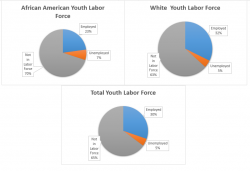Aug
2
2018

Written by Megha Patel
Generation Z, considered the most diverse generation and the last to be majority white, is already beginning to transform the American workforce. Pew Research defines Generation Z as individuals born after 1996 who have never experienced lack of access to technology. For the nonprofit sector, this generation is an opportunity to implement more diverse and inclusive practices. One would think inclusive workplace practices would be a top priority for the most diverse generation ever to enter the American workforce. However, it is becoming clear that the current Administration’s divisive rhetoric and policies will have rippling effects on their willingness to speak out about racial disparities and discrimination in the workforce.
The Current Disparities in the Labor Market
Historically, racial bias has caused higher unemployment and underemployment rates amongst People of Color. The Federal Reserve Bank of Atlanta, for example, reported that the current unemployment rate among African Americans is “more than 3 percent higher than the total unemployment rate.” The Federal Reserve, in their 2015 report “Experiences and Perspectives of Young Workers“, emphasizes that African American youth are “not obtaining full-time, steady work” at the same rate as their white peers. This report also suggests that Latinx youth entering the labor market experience similar disparities. Our 2018 research on the current trends amongst the Gen Z cohort, sourced from the latest BLS Current Population Survey, is consistent with the Federal Reserve’s findings on previous generations, suggesting higher unemployment rates among Gen Z People of Color (ages 16-19) than the national average. Although most people in this cohort are not yet in the labor force, African American youth are experiencing a 7% unemployment rate as opposed to the 5% unemployment rate amongst their white peers. African American Gen Zs are also 7% less likely than whites in their cohort to have not yet entered the work force. If these patterns continue, Generation Z people of color will experience the same disparities in the labor market as the last generation.
The Trump Administration and Youth Views on Politics
Another source of concern is the divisive rhetoric to which Generation Z is exposed under the Trump Administration. PRRI’s “Diversity, Division, Discrimination: The State of Young America” survey finds that “Eight in ten (80%) black young people and a majority of API (55%) and Hispanic (52%) young people say race relations are a critical issue to them personally, while only 37% of white young people agree.” However, “Asians and Pacific Islanders (35%), black (30%), and to a lesser extent Hispanic young people (24%) are significantly more likely than white young people (4%) to have experienced racially-motivated discrimination in the last 12 months.”
This rhetoric feeds into white racial anxiety and contributes to greater racial polarization. Nearly half of young white males (48%) believe diversity efforts will harm white people. White females on the other hand are not as likely to say that diversity harms white people. “One in five (20%) young women say they have personally experienced discrimination because of their gender.” While people of color and women support diversity, their white male peers are more concerned about how diversity affects their perceived quality of life. The question now is how these divisive views and priorities will evolve into future workplace policies.
Diversity Without Inclusion
Current data collected on Generation Z suggests increased polarization on issues of workplace diversity and inclusion policies, a worriying trend in light of already existant concerns around diveristy efforts that don’t center inclusion. Indeed, both Harvard Business Review and Deloitte have found that diversity efforts in the workforce don’t prioritize inclusion, even though the benefits of doing so are enormous, including increases in team performance and team collaboration.
Nonprofit organizations are also guilty of mistaking diversity and inclusion as one blanket effort. 1/3 of People of Color responding to BMP’s Race to Lead Survey reported that their race/ethnicity negatively impacted their career advancement, and anecdontal evidence suggests that policy without enforcement and culture shift (aka diversity) are insufficient to creating a truly inclusive workplace environement. By promoting culture shift in addition to policy change, nonprofits can lead by example and support a sector and generation in practicing what they preach.
While it remains to be seen how overall trends in employment will affect Generation Z, it seems evident that diversity without inclusion is a forgone conclusion if no effort is made to redirect this trend. Members of Generation Z have the opportunity to use their voices to promote inclusive practices and minimize disparities in the labor market despite the increasingly divisive rhetoric of the Trump Administration. If organizations encourage this generation to push for inclusion and fight the effects of divisive politics, the US workforce can expect to see positive outcomes for their organizations’ goals and for Generation Z’s career growth and satisfaction.
* Data sourced from BLS Current Population Survey for January 2018
